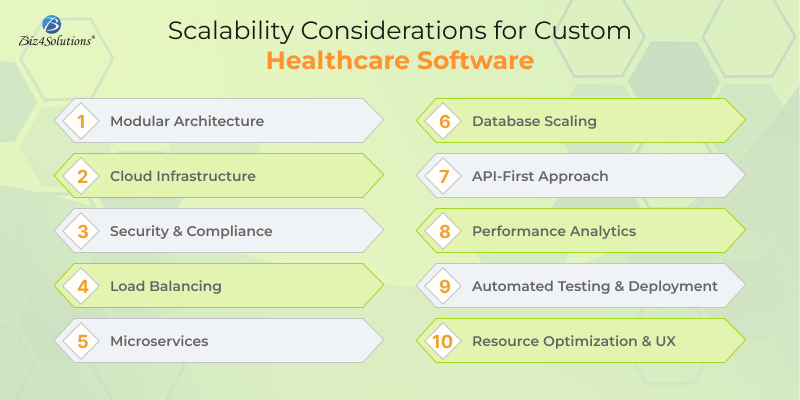In today’s era of digital health and healthcare IT solutions, scalability has become a crucial factor in custom healthcare software development. With the rise of telemedicine, mHealth apps, and digital transformation in healthcare , systems must be designed to handle expanding workloads, diverse user needs, regulatory requirements, and emerging technological trends. A scalable solution ensures not only high availability and performance but also future-proof healthcare software that adapts to evolving clinical and business needs.

- Modular Architecture
- Cloud-Based Infrastructure
- Data Security and Compliance
- Load Balancing
- Microservices and Containerization
- Database Scalability
- API-First Development
- Performance Monitoring and Analytics
- User Experience (UX) Design
- Automated Testing and CI/CD
- Resource Optimization
A modular approach enables healthcare systems—such as EHR/EMR platforms , telehealth applications, and patient engagement portals—to add or update functionalities without disrupting existing services. Decoupling components ensures that features like patient records, appointment scheduling, or billing systems can be independently scaled and enhanced.
Cloud computing in healthcare provides elastic scalability, cost efficiency, and robust disaster recovery. Leveraging cloud platforms allows providers to dynamically adjust storage and processing power as healthcare big data grows. Modern cloud vendors also ensure HIPAA compliance , data governance, and advanced security for sensitive patient information.
Maintaining HIPAA-compliant software development practices, along with GDPR and HL7/FHIR interoperability standards, is vital for patient data privacy. Scalable systems must implement strong cybersecurity protocols, encryption methods, and continuous compliance monitoring to safeguard sensitive health data.
Effective load balancing ensures that healthcare applications can support high volumes of concurrent users—whether doctors accessing clinical dashboards or patients using telemedicine platforms—without performance degradation. Distributing traffic across multiple servers improves both reliability and scalability.
A microservices architecture, often supported by containerization technologies like Docker and Kubernetes, allows healthcare software to be developed and deployed in small, independent services. This approach enables horizontal scaling and greater fault tolerance, ensuring resilience for mission-critical applications such as real-time health monitoring or IoT-enabled medical devices.
Healthcare generates massive amounts of data, from EHRs to IoT medical device streams. Mechanisms like sharding, database partitioning, and NoSQL databases are employed for scalable performance. Hybrid database strategies balance structured patient records with unstructured data from wearables and imaging systems.
Scalable healthcare software must integrate seamlessly with external platforms. API-first development enables smooth interoperability with EHR systems, insurance platforms, IoT devices , and third-party healthcare applications. Adhering to standards like FHIR APIs ensures flexibility for future integrations.
Real-time monitoring and predictive analytics help identify performance bottlenecks and anticipate scaling needs. For healthcare providers, this translates to uninterrupted services during peak demand periods, such as telemedicine sessions or vaccination drives.
Serving a diverse user base of nurses, doctors, patients, and administrators is a must-have trait of scalable software. Mobile health app UX design should adapt seamlessly across devices, ensuring accessibility and improving patient engagement while supporting large-scale adoption.
Healthcare systems evolve rapidly with regulatory and clinical updates. Automated testing and Continuous Integration/Continuous Deployment (CI/CD) pipelines accelerate delivery cycles, ensure system stability, and support compliance validation while scaling efficiently.
Efficient use of memory, storage, and compute power keeps systems responsive as user numbers and datasets expand. Techniques such as caching, serverless architecture, and efficient data algorithms improve scalability and reduce costs for healthcare providers.
Key Takeaways
Scalability in healthcare software development services goes beyond handling more users or data—it ensures future-proof healthcare IT solutions that can adapt to new technologies, patient expectations, and regulatory landscapes. By leveraging cloud infrastructure, microservices, containerization, interoperability standards, and performance monitoring, developers can build robust, compliant, and cost-efficient solutions that support the ongoing digital transformation in healthcare.
